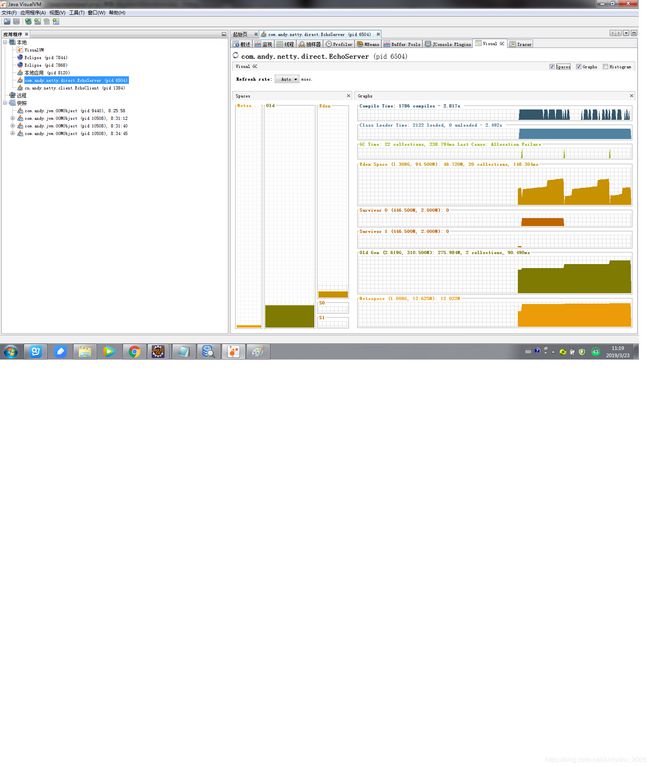netty中的Bytebuf管理
前言
netty中的Bytebuf类似于java nio中的ByteBuffer。不过,与原生的ByteBuffer相比,Bytebuf采用了读写两个指针,使用起来更加方便,不至于每次在读写切换过程中都需要flip()操作。而且Bytebuf支持动态扩展。
netty为了实现高效操作,对Bytebuf设置了两种实现,一种是在堆上实现的HeapBytebuf,另一种是在堆外实现的DirecetBytebuf。DirecetBytebuf避免了Bytebuf在用户区与内核区的数据复制过程,效率更高。但是在堆外操作内存(创建与销毁工作)效率是比较低的,为了提升效率,netty又提供了内存池,包括DirecetBytebufPool和HeapBytebufPool。
Bytebuf的内存管理是由引用计数器管理的。在进行Bytebuf的相关操作时,尤其要注意其创建与释放过程,避免内存泄漏。
1、基于PoolDirecetBytebuf的内存泄漏问题
1.1 问题复现
我们在netty服务端,简单设置一个EchoServerHandler,用于查看PoolDirecetBytebuf的内存泄漏问题。EchoServerHandler基于ChannelInboundHandlerAdapter实现,其channelRead方法如下:
@Override
public void channelRead(ChannelHandlerContext ctx,Object msg){
ByteBuf in=(ByteBuf) msg;
byte[] body = new byte[in.readableBytes()];
in.readBytes(body);
}
几乎什么都没有操作,在channelRead中,ByteBuf in默认采用池化的directBytebuf实现。为了监测directBytebuf是否在不断增长,参考https://www.jianshu.com/p/4e96beb37935的做法,自定义一个类,用于查看io.netty.util.internal.PlatformDependent类中DIRECT_MEMORY_COUNTER这个静态变量的值(此值用于统计已经分配的直接内存大小)。
public class DirectMemoryLeakReporterImpl {
private static final int _1k=1024;
private static final String BUSINESS_KEY="netty_direct_leak";
private AtomicLong directMemoryCount;
public void init(){
java.lang.reflect.Field field=ReflectionUtils.findField(PlatformDependent.class, "DIRECT_MEMORY_COUNTER");
field.setAccessible(true);
try {
directMemoryCount=((AtomicLong) field.get(PlatformDependent.class));
} catch (Exception e) {
// TODO: handle exception
}
}
public void startReport(){
ScheduledExecutorService service=Executors.newScheduledThreadPool(1);
service.scheduleAtFixedRate(runnable, 0, 1, TimeUnit.SECONDS);
}
Runnable runnable=new Runnable() {
@Override
public void run() {
// TODO Auto-generated method stub
try {
int memoryInkb=(int)directMemoryCount.get()/_1k;
System.out.println(BUSINESS_KEY+"--->"+memoryInkb);
} catch (Exception e) {
// TODO: handle exception
System.out.println(BUSINESS_KEY+"--->"+e.toString());
}
}
};
}
在启动netty服务之前,先启动此类。
在客户端,我们定义了一个类,不断向服务端发送数据,为了快速验证,每次发送的数据包都比较大
@Override
public void channelActive(ChannelHandlerContext ctx) throws Exception {
// TODO Auto-generated method stub
for (int i = 0; i < 1000000; i++) {
StringBuilder builder=new StringBuilder();
for (int j = 0; j < 1000; j++) {
builder.append("netty rocks,netty rocks!");
}
ctx.writeAndFlush(Unpooled.copiedBuffer(builder.toString(),CharsetUtil.UTF_8));
System.out.println("发送数据"+count++);
TimeUnit.MILLISECONDS.sleep(500);
}
}
然后运行,看执行结果,客户端发送了大概1500次之后
netty_direct_leak--->16384
netty_direct_leak--->98304
堆外直接内存分配大小从16384K增长到了98304K,即从16M增加到90多M。说明堆外内存已经发生了泄漏。
1.2 解决方案
由于是ByteBuf in进行了内存的申请,但没有释放,因此可以通过ReferenceCountUtil.release(in)来手动释放
@Override
public void channelRead(ChannelHandlerContext ctx,Object msg){
ByteBuf in=(ByteBuf) msg;
byte[] body = new byte[in.readableBytes()];
in.readBytes(body);
ReferenceCountUtil.release(in);
}
又或者让我们的EchoServerHandler继承SimpleChannelInboundHandler实现,然后我们自定义实现其中的channelRead0方法,通过查看源码可知,SimpleChannelInboundHandler类中的channelRead每次在结束时,都会手动释放: ReferenceCountUtil.release(msg);
又或者,让我们的EchoServerHandler每次处理完,都firechannelRead,让我们netty内部框架实现的TailContext来最终完成传入的消息的手动释放内存。
2 基于PoolHeapBytebuf的内存泄漏问题
由于堆外内存是不归虚拟机管理,因此需要我们手动操作释放内存,那么基于heap实现的Bytebuf,是否需要我们手动释放内存呢。
对上述的服务端的代码进行稍微改动:
public class EchoServerHandler extends ChannelInboundHandlerAdapter {
//定义用于生成heapBytebuf的内存池实现
PooledByteBufAllocator allocator=new PooledByteBufAllocator(false);
@Override
public void channelRead(ChannelHandlerContext ctx,Object msg){
ByteBuf in=(ByteBuf) msg;
byte[] body = new byte[in.readableBytes()];
in.readBytes(body);
ReferenceCountUtil.release(in);
//创建heapbytebuf
ByteBuf heapBuffer = allocator.heapBuffer(100000);
heapBuffer.writeByte(10);
}
每次收到数据后,都手动创建一个大容量块的heapBuffer ,其由基于heapBytebuf的内存池实现。
客户端方法仍旧一致,让其运行,通过JvisumalVm查看,

 说明如果我们手动创建了基于heap的Bytebuf,那么也是要手动进行释放的,否则也会发生内存泄漏。
说明如果我们手动创建了基于heap的Bytebuf,那么也是要手动进行释放的,否则也会发生内存泄漏。
3 基于响应的Bytebuf
如果最终的Bytebuf进行了Write或者WriteFlush操作,那么Netty系统会自动的 为这个Bytebuf进行内存释放的工作。
4 Bytebuf的内存管理注意事项
上面说了Bytebuf是基于引用计数器进行管理的,即通过判断refCnt的值来判断这个Bytebuf是否可以继续使用。有时候如果refCnt已经为0了,而我们想要继续操作这个Bytebuf,那么系统就会报错。通过ReferenceCountUtil这个类,可以完成Bytebuf的refCnt的值的增加与减少。
ReferenceCountUtil.release(Bytebuf);
将Bytebuf的引用计数-1,如果引用计数减少后未0,就返回true,否则返回false。所以,有时候我们确实想要释放一个Bytebuf,但是又不知道其引用计数是多少,可以通过一个while循环,不断的调用ReferenceCountUtil.release,直到其返回true为止。
ReferenceCountUtil.retain(Bytebuf);
通过这个方法,可以增加 Bytebuf的引用计数,避免有些情况,引用计数为0,而导致不能使用Bytebuf。